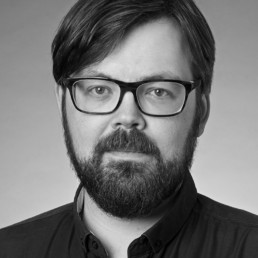Renegotiating Data Ecologies through Trees, Soil, and Pigs’ Lungs
This article investigates examples of artistic practices that all somehow deal with establishing relations to the world and environment around us in an age of pervasive technological mediation which runs parallel with increasing threats of pollution and climate change – partly generated exactly by our consumption and dependence on technology. Digital interfaces and ubiquitous networks of data streams are constantly filtering our experience of the world, and this often takes place as habitual and hidden processes. Counter to this non-reflective relation between the world and technology, a number of contemporary artists are working critically with re-defining how we engage with data and digital technologies in different ways. In this article, the theme of ecological modes of engagement is discussed through three art works/projects which address one of the most pressing issues of the Anthropocene, namely our measurable, environmental impact upon the world, as well as our possibilities for connecting, in atypical ways, with the signals and currents that run through the heavily technologized atmospheres of our city spaces.
Introduction
[W]hen you mention the environment, you bring it into the foreground. In other words, it stops being the environment. It stops being That Thing Over There that surrounds and sustains us. When you think about where your waste goes, your world starts to shrink.1Timothy Morton, Ecology Without Nature: Rethinking Environmental Aesthetics, Cambridge, Harvard University Press, 2007, p. 1.
If one were simply to follow philosopher Timothy Morton’s argument cited above, ‘discourse’, or rather the sheer act of enunciation pointing toward a shared but nevertheless abstract concept of environment, seems to entail a sort of feasibility process through which we can begin to grasp the world. The phenomenon here associated with this becoming-conscious of the world is ‘waste’ – one of the most obvious side effects of our interactions with and usages of the planet, the others being resource exhaustion and climate change/global warming, which all add up to the so-called Anthropocene. But will discourse alone bring us closer to an understanding and sense of the environmental impact of our interactions with and usages of the world and its materials? History seems to have proved that this is not the case, as issues concerning global warming are continuously piling up, despite decades of debate. One of the sites of response to a purely ‘discursive’ or ‘symbolic’ approach toward environmental complications, is that of art and artistic practices. This also resonates with a more recent statement provided by Morton concerning our age of “ecological awareness” in which we, according to him, will “come again to think of art as a demonic force, carrying information from the beyond, that is, from nonhuman entities, such as global warming, wind, water, sunlight and radiation. From coral bleaching in the ocean to the circling vortex of plastic bags in the mid Atlantic”.2Morton, Timothy, Realist Magic: Objects, Ontology, Causality, University of Michigan Library, 2013, p. 22.
Taking our point of departure from these very general considerations via Morton, this article will look into examples of what might be called practices of ‘aesthetic politicization’ which involve ecologically- and environmentally-oriented artistic works that address exactly the ambivalence between discourse and material action. These are also examples that may be said to operate on different parts of a continuum relating to questions of the production and consumption of data. This is a continuum which includes, for instance: large data sets that are captured, monitored and interpreted, the production of computational technology itself and the energy used to drive it, and the kind of data which is generated beyond immediate directionality and programmability. A crucial question of the article will be whether artistic strategies of intervening with and translating data through unusual – perhaps ‘post-digital’3Christian Andersen, Geoff Cox and Georgios Papadopoulos (eds.), Post-Digital Research, APRJA (4), 2014. – media, can in fact help us fathom and address the complicated issues concerning the double relation between technology and Earth, pointing towards other, more conscious and environmentally balanced modes of digital and post-digital ecologies. We thus like to ask if strategies of applying aesthetic means, and the host of art world conventions that accompany these, will make issues about global warming, waste, and data comprehension more tangible4Panagia, Davide, The Political Life of Sensation, Durham and London, Duke University Press, 2009; Lone Koefoed Hansen and Jan Løhmann Stephensen, “Making (In)tangible Arguments about Play, Creativity, and the Political Economy of 3D Printing: The Free Universal Construction Kit”, tripleC 13(1), 2015, pp. 112–135., or instead, further obfuscate things?
The Environmental Sentinel
One example of what we suggest involves a process and act of aesthetic politicization, could be Frances Whitehead’s art project, The Environmental Sentinel (2014-2016). A project, which is currently under construction – actually it is being planted and growing – in Chicago as part of the Rails to trails program, where abandoned rails are repurposed into parks all over the US. Whitehead’s project, which can be best described as a hybrid of art and design, science, natural flora, urban planning of recreational practices and spaces, local as well as global politics, thus seeks to stir up a local ‘climate public’ through aesthetic means (in this case meaning ‘sensual’ and/or ‘tangible’). Whitehead’s own explanation concerning the necessity of the project is much in line with the overall argument of this article, namely that it
“emerges from the cultural hypothesis that sustainability and climate change are culturally-driven conditions and that cultural strategies can/must be used to make these issues tangible and legible to the public.”5Francis Whitehead, Environmental Sentinel: A Climate Observation Artwork + Related Recent Work, Chicago: ARTetal Studio, 2015, p. 5.
Climate change cannot be tackled through technological fixes. We need cultural and artistic ones as well.
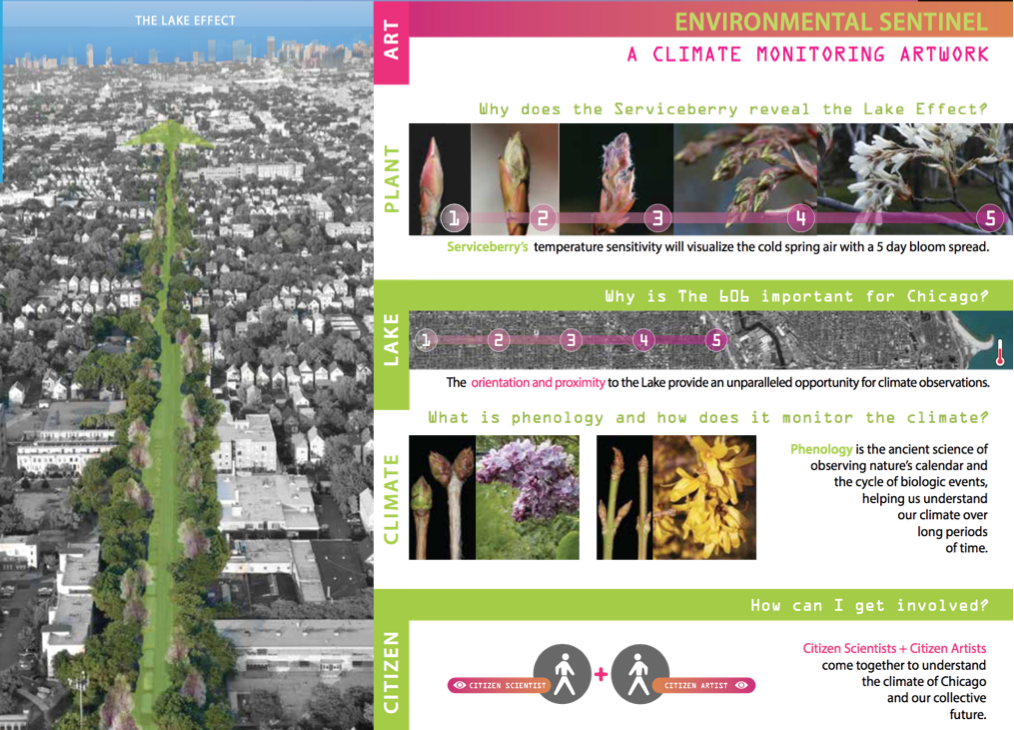
The issues addressed in Whitehead’s project are, on many levels, about the entanglement of environment/climate, technologies, political discourse and the human sphere of action. In a sense, Whitehead’s project is quite scientifically based: it is about climate change studied through phenology (the science of blossoming/plant and animal life cycle events). Yet, it does not utilize any technologies, scientific apparatuses or measuring devices the way we would perhaps normally expect. Instead, Whitehead has designed an installation of 453 apple serviceberry trees on a long straight line that will allow users of the park to visually track annual changes in when the trees first blossom, hence constituting a “climactic centennial for the city […] that will bring trail users face-to-face with the effects of climate change”6Lori Rotenberk, “When it comes to climate change, this artist lets the trees do the talking”, Grist, 3 December, 2013.. This is achieved by making use of Chicago’s lake effect, which in spring (and in fall) has the effect of spatially “compressing” distributed temperature deviations – caused by the coldness of the waters versus the warmer winds from South/Southwest (cp. illustration 2) – into a shorter distance than normal, in combination with the fact that these particular trees are very sensitive to temperature and bloom in a fascinating way.
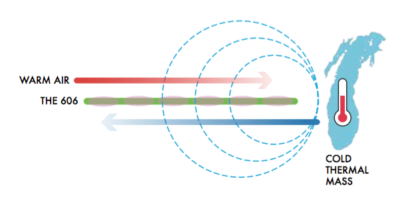
The apple serviceberry trees thus come to have a dual function: as “sensors” that monitor climate change, and as public “screens” that document or display climate change. A phenomenon, which we typically otherwise grasp through complicated climate models that rely on and represent huge amounts of data; but which we at the same time may find fundamentally difficult to comprehend; a fact, Timothy Morton has also indicated by referring to climate change as a so-called “hyperobject” par excellence (2013).7Morton, Timothy, Hyperobjects: Philosophy and Ecology after the End of the World. Minneapolis: University Of Minnesota Press, 2013. Another crucial feature concerning this is the fact that the data, on which these models are all based, are of a magnitude that can only really be extracted, processed and calculated through the use of contemporary computational technologies and the algorithms they facilitate.
On the one hand, of course, the trees are obviously pre-digital things; and in addition to this, they are things that would have reacted to climate change the same way, regardless of digital interventions. The trees are emphatically non-technological in almost every sense of the word. But on the other hand, their specific application as a technology of monitoring and displaying climate change is obviously deeply enmeshed with our digital world. This is also emphasized by the fact that every tree will be tagged, numbered and geo-coded, so that both volunteers and professionals can use the barcoded trees for data collection.
Hence, the trees could actually be said to function as ‘post-digital’ technologies or media.8Andersen et al. Although being just trees, even trees – at least in some instances, uses and circumstances – are not just trees; they are trees in a world of digital technologies and data. And the very act of applying trees as media of research and communication is a deliberately demonstrative gesture against-the-grain of the hegemony of digital technologies; a gesture that takes place – and can only really take place
“after the initial upheaval caused by the computerisation and global digital networking of communication, technical infrastructures, markets and geopolitics”9Florian Cramer, “What Is Interface Aesthetics, or What Could It Be (Not)?” in Christian Ulrik Andersen and Søren Bro Pold (eds.), Interface Criticism – Aesthetics Beyond Buttons, Aarhus, Aarhus University Press, 2011, pp. 117–29..
In this sense, the trees can be seen as attempts to move beyond the dichotomy of rather “dry” data-representations, on the one hand; and on the other: formalized and conventionalized environmental “clip art-visuality” (e.g. manipulated visual/photo memes of polar bears and penguins stranded on ice flakes). The trees are an attempt to do something differently, to politically aestheticize these issues, in order to “spark a [climate] public into being”10Noortje Marres, “Issues spark a public into being: A key but often forgotten point of the Lippmann-Dewey debate” in Bruno Latour and Peter Weibel (eds.), Making Things Public. Cambridge, MIT Press, 2005; Marres, Material Participation: Technology, the Environment and Everyday Publics, New York, Palgrave Macmillan, 2012., that is, to stir up attention, discussion and action. This is to be achieved not only by using phenology, but also a phenomenological approach, a way of speaking to the senses, one might say. This simultaneously stresses the global/local-dimensions of current climate change, especially the problem of how a phenomenon of this scale, cp. Morton’s hyperobject, can be experienced as an everyday “felt problem” in such a way, that, without losing its global implications, it can appear politically addressable.
In this sense, there is almost some kind of ‘interlocutorship’ at stake in Whitehead’s project. Or as journalist Lori Rotenberk puts it: “When it comes to climate change, this artist lets the trees do the talking”11Rotenberk.. Yet, this is a postulate, which should be instantly modified, since “the talking of the trees” probably cannot stand on its own. Their “statements” or “arguments” are obviously referring to and drawing on previously acquired knowledge and already-heard political arguments internalized by the trail users that are the potential “listeners” of this nature/science-installation about climate change. Without this implicit ‘paratext’–most of which is so peripheral to the actual art project that it borders on being ‘context’–it is actually quite hard to imagine how anyone could make sense of this project otherwise,12This is, of course, a problem that is not restricted to the part of contemporary art that deals specifically with issues of the environment or datafication as such, but that’s another story. and thus spark a climate change-public into being.
YoHa – Coal Fired Computers
As somewhat opposed to Whitehead’s trees that function as the prime interface between intangible fluctuations of temperature, air quality, etc., the following example of an artistic practice that deals with pollution, more explicitly links computational technology, data and digital processes with their impact on organic materiality while exploring the intricate exchanges between these phenomena. However, the British artist group YoHa’s (Matsuko Yokokoji and Graham Harwood) practice is also closely connected with questions about the ‘tightness’ between specific artistic or ‘artefactual’ articulations and the data and datasets they are meant to represent. In other words, this is also about data translations, as mentioned above, concerning how we make sense of data through aesthetically- and semantically-coded processes.
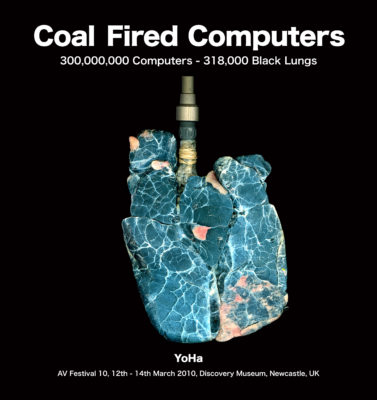
With their installation, “Coal Fired Computers” (2010), YoHa addressed what they refer to as the overwhelming “information circulating the world in wires, compressed into databases” which “fuels” both ecological, economic and social crises (YoHa, 2010). Through a combination of physical installations and data on coal consumption, YoHa offered an alternative visualization, and to some extent, tangible, representation of the otherwise-hidden information about the dire environmental and medical effects of everyday Western European data usage. Under the headline, “300.000.000 Computers – 318.000 Black Lungs”, this installation invites its audience to reflect on the general level of environmental and health-related impacts of 21st century coal mining and its subsequent usage for producing computational technologies. Technologies which are, again, driven by electricity generated from fossil fuel power stations. One of the strictly political issues related to this piece is the fact that the western world has, to a large degree, displaced the initial mining process to countries far away – while simultaneously cloaking the Western world’s continued reliance on “black energy” under the labels of “weightlessness” and “immateriality”.13Marisol Sandoval, “Foxconned Labor as the Dark Side of the Information Age: Working Conditions at Apple’s Contract Manufacturers in China”, TripleC–Communication, Capitalism & Critique, 11(2), 2013, pp. 318–347; Richard Maxwell and Toby Miller, Greening the Media, Oxford, Oxford University Press, 2012, pp. 27–30. As YoHa puts it, the coal dust of this highly hazardous work now finds its way “into the lungs of unrecorded, unknown miners in distant lands”. However, as it is furthermore argued: “coal returns into our lives in the form of the cheap and apparently clean goods we consume”. YoHa lay this out in their own description of the work in the following way:
“Coal fired energy not only powers our computers here in the UK, but is integral to the production of the 300,000,000 computers made each year. 81% of the energy used in a computer’s life cycle is expended in the manufacturing process, now taking place in countries with high levels of coal consumption.”14cp. http://yoha.co.uk/cfc.
The critical agenda of YoHa is, thus, rather explicit: It addresses the power relations at the foundation of contemporary media ecologies which can be tracked all the way from the production of computer-technological consumer goods to the energy sources that drive the innumerable microprocessors and electrical devices which have become crucial to our production, communication, and recirculation of abstract data. As an actual installation, Coal Fired Computer combined various elements that together created a kind of aesthetic experience through which the audience was confronted with these circumstances. The description on YoHa’s website explains the core of what the installation comprises:
“A one-hundred-year-old, 18-ton showman’s steam engine powers a computer with 2.5 tons of coal. Black lungs inflate every time a database record of miners’ lung disease is shown on the computer monitors. It feels like you’ve been invited into a fun fair, but one where the rides log their own accidents – a fun fair run by people who long ago became indistinct from the machines they maintain.”15cp. http://yoha.co.uk/cfc.
Outside of the gallery space the audience then had to pass by the steam engine in order to enter the gallery room in which the most central components of the installation were placed; that would be the computer technological devices mentioned above powered by a coal fired boiler, a pair of real pigs’ lungs hooked up with pneumatic mechanism, all placed side by side on a long table that served as a non-pretentious ‘piedestal’ for the whole setup.

The literal juxtaposition of the boiler and the pigs’ lungs next to the computer devices highlights the considerable power usage of digital technologies which we generally do not give much consideration to. The critique implied in Coal Fired Computers thereby conflated the abstract site of everyday data production and consumption with the actual materiality of our computers.
Giving attention to these facts which are, from an ecological point of view, clearly problematic, YoHa place themselves amongst a number of artists who aim to “establish proximity, map the links, the continuum of media natures where the natural ecology is entirely entangled with the technological one”16Jussi Parikka, A Geology of Media. Minneapolis, University of Minnesota Press, 2015, p. 63.. In his recent book on the “geology of media”, Parikka points exactly to such artistic practices (concentrated on making this type of critical inquiry toward understanding the meaning and impact of contemporary data ‘culture’ and sheer data usage). Overall he refers to these as “speculative media arts that addresses in assays and technological assemblages the substrate as part of our media systems”17Ibid., p. 49.. Parikka’s discussion provides an elaborate account of how artistic projects and processes may address the often not-so-clear interrelations between media and the ‘ecological’. Interrelations that tend to be left out of a certain theoretical discourse that describes and relates media to notions of ‘environment’ or ‘environmental’ aspects, but without any specific attention toward the obvious ecological aspects concerning pollution, e-waste etc.18This would the case, for instance, with the way in which Mark B.N. Hansen understands ‘environment’ rather as referring to the kind of intricate human-machine circuitry, which is an inevitable result of 21st century digital technologies. Cp. Mark B.N. Hansen, Feed Forward: On the Future of the 21st Century Media, Chicago, University of Chicago Press, 2014. The same could be said of Joshua Meyrowitz’ (2006) notion of media as “an environment” in extension of McLuhan’s so-called … Continue reading
In contrast, YoHa’s strategy seems to pinpoint the actual and physical connection between computational technologies (i.e. the ‘Grundstoff’ of contemporary media art) and the materials used for providing these in the first place. So while YoHa largely base their work on datasets to represent the (environmental and health) implications of consumption of data via digital devices, they link this directly with organic tissue through which the ‘natural environment’ is made present. The pigs’ lungs, thus, act as a kind of physical materialization, a kind of bio-kinetic display, translating the direct impact of coal dust inhalation. As the increasing blackness of the pigs’ lungs manifests itself, induced by the data feed monitoring the miners’ health state, the installation can also be experienced as a sort of interface. That is, if we consider the function of interfaces more generally as something which concerns “how humans … perceive the world via the organisational and sensory structures programmed into the device”19Cramer, p. 119., it should be noted that Florian Cramer’s phrasing of this definition of interface is in the context of a discussion about interface aesthetics. It thus relates closely to the directly experiential aspects of the sensemaking and knowledge production processes that are established when human users interact with technology. Furthermore, Cramer distinguishes two central modes of interface aesthetics as either one of “perceptive transparency” or “opacity” and “obscurity” – i.e. one mode which makes the inner workings of the technology behind the interface open to inspection and makes possible an immediate understanding of it, and one mode which smoothes out or hides those technological properties as well as the connection between technological basis and user operations via the interface.20Ibid., p. 121. With Coal Fired Computers, there is no direct user interaction, but the main function of the pig’s lungs may be said to imply a manifest ‘disclosure’ of the material basics of the complex computational networks which both feed the installation itself and comprise a still more substantial part of our life world. Conceived as an aesthetic interface, YoHa’s work presents its recipients with an explicit and, to some degree, transparent experience of the environmental impact of our consumption of data via digital devices and the politics of outsourcing health-damaging industries to countries at a convenient distance.
Earthcodes and booting from soil
We will introduce and discuss one last example of an artistic practice which relates to the above discussion regarding the function of art works and installations as both ‘interlocutors’ and ‘interfaces’. This concerns the British/German artist Martin Howse, who operates in a field somewhere in between earth, technology and unruly software. Many of his projects can be described as highly exploratory and experimental in dealing with ways of reappropriating and reconnecting with the Earth and its energies. This has partly been the focus of the constellation microresearch lab, where Howse examined such processes in a way that may initially seem to be scientific in its approach rather than oriented toward galleries and the art world. Parikka describes how this type of project is “closer to laboratory experiments than an exhibition”, adding that,
“instead of a stabilization of materials as in scientific processes, they aim to look for variations and the strata of the earth reterritorialized as technology”21Parikka, p. 74..
This also relates to other parts of his artistic practice carried out alone or as a conductor leading participative workshops. One of his more recent ventures is, “The Earthcodes Project”22cp. http://www.1010.co.uk/org/earthcode.html., which comprises “a series of experimental situations which explore the notion of an earth computer” one of which is named “Earthboot”. The background for this is furthermore described on Howse’s website in the form of two short texts. Concerning “Earthcode”, he refers to concepts such as “networked machinery”, “code”, “software”, “the geological” while adding that the project
“proposes an intentionally literal, artistic series of experimental situations which explore the notion of an earth computer, a computational device inscribed or doped both on the skin and on the earth substrate itself.”23Ibid.
According to Parikka, this is a project that takes the “uses and abuses of speculative hardware…into a further viscous proximity with the earth”24Parikka, p. 75..
As a specific manifestation of “Earthcodes”, Howse has constructed an “Earthboot” setup, which literally makes use of the natural electrical current in the ground found in various spots of different cities – so-called “telluric currents” 25cp. http://www.1010.co.uk/org/earthcode.html..
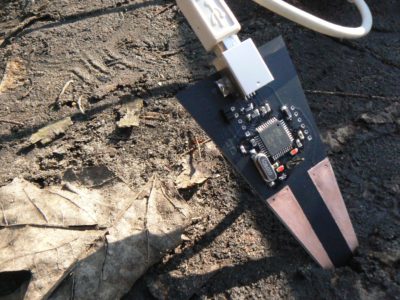
This energy is then used to boot up a computer and instead of the regular BIOS (basic input-output system), Howse establishes a direct connection between flows of electricity in the earth itself and his computer through self-made devices plugged into the ground. Thus, in a sense the processed and refined materials of the computer’s circuits are connected with the soil and the raw minerals which originally went into the production of it, and which will stay with us for quite some time in the shape of ‘digital rubbish’26Jennifer Gabrys, Digital Rubbish: a Natural History of Electronics, Ann Arbor, The University of Michigan Press, 2011.. Howse addresses this by explaining that Earthboot
“enables almost any computer to boot straight from the earth, sidestepping dirty mining actions, and the expensive refining and doping of raw minerals; thus avoiding environmentally wasteful production techniques for the construction of data bearing devices such as hard drives or USB memory sticks.”27cp. http://www.1010.co.uk/org/earthcode.html.
Mixing a savvy rhetoric informed by computer-technological and scientific terms with rather obscure references to Victorian literature, Howse suggests – or at least gestures toward – a link between technology and earth that sidetracks the directional logic of algorithms and computational processes with an end goal typically being outputs that are meaningful and easily readable. In the words of Howse, the project is more to be seen as a proposal for “a barely functional telluric operating system (OS), exposing the vampirism of current technology”, thus somehow parallelling the critical agenda of YoHa concerning the problematic energy consumption of contemporary computer technologies, as mentioned above.28Ibid. Another important aspect of Howse’s project is how it points toward the interaction processes between human and technological agency.
While the description of the Earthcodes project seems to save, at least some, space for human interference through an interface of the “skin” – something which Howse has also worked into the control system of a series of self-engineered synthesizers – the Earthboot project largely leaves out any pronounced human intervention in the process. The latter, then, is much on par with the flatter ontology of new materialism and like-minded contemporary theories. In a recent interview, Howse explained how Earthboot is first and foremost about interactions between earth and technology, not caring much about an actual (human) user perspective. It, thus, concerns how:
“the earth is not separate from technology, but that it can write code, write software–literally hard code which is running on the computer. You plug the device into the earth and what is running on the computer is nothing but what the earth has generated. I’m doing a kind of very minimal translation, obviously, but it’s not a transposition or an interpretation. It’s rather a translation which takes place within the same energetic sphere that is electrical impulses which then boots the computer as a set of instructions. To me there is no ‘data’ as such because the process hasn’t entered that symbolic sphere.”29Thomas Bjørnsten, “Art beyond the critical human perspective – an interview with Maritn Howse”, 2015.
From this statement we see that Howse’s artistic practice and the discourse through which he himself frames it, hints at the kind of ‘proximity’ between a natural and technological ecology mentioned above, also by Parikka. Thus, one could understand the particular works, artifacts and installations by Howse as mediating interfaces between 1) a position which foregrounds human interpretation as a way of relating to and understanding the environmental conditions of the earth and 2) a strictly technologically-based measurement of currents, fluctuations and signals that provide the basic ‘data’ for such interpretations in the first place. However, in contrast to YoHa’s work, Howse asserts that his work/project does not have an explicitly critical or political agenda to it, even though it can be seen as relating to present discourses on ecology and environment. What Howse is more interested in, is to question our notions of what ecology is:
“[T]his idea of ecology … always involves these human systems and economies or is somehow a view of so-called called ‘nature’ which obviously doesn’t really exist – well, beyond existing as an illusion or utopia […] Obviously I cannot operate on a huge scale, so what I do is these kinds of scaled–down investigations. But really it’s about where this idea of ecology does come from, what is it really doing? Talking for these things that aren’t human?”30Ibid.
Especially in the last passage of this quote, Howse seems to hint at the shortcomings of the human artist’s perspective and possibilities for actually addressing large-scale phenomena such as ‘the environment’ or ‘ecology’. In a way, this is a challenge which can be said to imply a kind of fundamental aporia of the Anthropocene; namely how to properly discuss and make sense of something so vast and all-encompassing as the Earth and environment without reducing and simplifying their complex properties through insufficient scalings and interpretations. A typical means for such complexity-reduction, seen from a human point of view, would be through metaphorical or symbolic circumscriptions and translations, as these render abstract phenomena into legible concepts and cognitively manageable entities. But for Howse, the bringing together of materials derived from both refined digital technology and the unprocessed earth itself, forms what he also refers to as “scaled-down possibilities” (Bjørnsten, 2015.) that are not metaphors or symbolic stand-ins, but rather the plugging of digital devices directly into the ground, the bringing together of these materials and strata, make them literally act autonomously together. And often, according to unexpected and non-directional processes. As Howse also puts it: “Crashing is the price to pay for booting straight from the earth.”31cp. http://www.1010.co.uk/org/earthcode.html.
As such, these constellations of earth and technology establish a kind of ‘interlocutorship’ as discussed above in the case of The Environmental Sentinel. In a comparable manner, Howse let both sides ‘speak for themselves’ as well as ‘to’ each other while letting human interpreters tap only partly into this mono/dialogue. In Howse’s œuvre, the artifacts and installations displaying this process generally sidestep the more conventional ways of making sense of abstract electrical and digital signals which fuels his work. Furthermore, these signals will mostly be included in a pre-symbolic state (i.e. as ‘non-hygienisized’ or even ‘pre-data’). The aesthetic effect experienced from a number of Howse’s works and performances is therefore often of an immediate ‘glitchy’ or noisy character which is also the case with “Earthboot”.
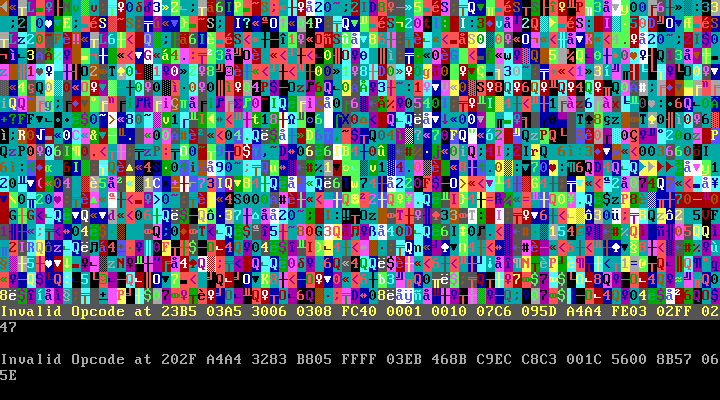
Yet, this aesthetic does not seem to be deliberately sought after, but rather the ‘natural’ outcome of the operation of connecting currents and unruly signals emerging in the soil with the standardized in/output system of the computer. In this way, the Earthboot functions both as ‘interlocutor’ and aesthetic interface, providing us with a sort of insight into these processes – however radically obscure or intriguingly appealing the result may appear – suggesting another type of data-ecology beyond a narrow human scope.
| ↑1 | Timothy Morton, Ecology Without Nature: Rethinking Environmental Aesthetics, Cambridge, Harvard University Press, 2007, p. 1. |
|---|---|
| ↑2 | Morton, Timothy, Realist Magic: Objects, Ontology, Causality, University of Michigan Library, 2013, p. 22. |
| ↑3 | Christian Andersen, Geoff Cox and Georgios Papadopoulos (eds.), Post-Digital Research, APRJA (4), 2014. |
| ↑4 | Panagia, Davide, The Political Life of Sensation, Durham and London, Duke University Press, 2009; Lone Koefoed Hansen and Jan Løhmann Stephensen, “Making (In)tangible Arguments about Play, Creativity, and the Political Economy of 3D Printing: The Free Universal Construction Kit”, tripleC 13(1), 2015, pp. 112–135. |
| ↑5 | Francis Whitehead, Environmental Sentinel: A Climate Observation Artwork + Related Recent Work, Chicago: ARTetal Studio, 2015, p. 5. |
| ↑6 | Lori Rotenberk, “When it comes to climate change, this artist lets the trees do the talking”, Grist, 3 December, 2013. |
| ↑7 | Morton, Timothy, Hyperobjects: Philosophy and Ecology after the End of the World. Minneapolis: University Of Minnesota Press, 2013. |
| ↑8 | Andersen et al. |
| ↑9 | Florian Cramer, “What Is Interface Aesthetics, or What Could It Be (Not)?” in Christian Ulrik Andersen and Søren Bro Pold (eds.), Interface Criticism – Aesthetics Beyond Buttons, Aarhus, Aarhus University Press, 2011, pp. 117–29. |
| ↑10 | Noortje Marres, “Issues spark a public into being: A key but often forgotten point of the Lippmann-Dewey debate” in Bruno Latour and Peter Weibel (eds.), Making Things Public. Cambridge, MIT Press, 2005; Marres, Material Participation: Technology, the Environment and Everyday Publics, New York, Palgrave Macmillan, 2012. |
| ↑11 | Rotenberk. |
| ↑12 | This is, of course, a problem that is not restricted to the part of contemporary art that deals specifically with issues of the environment or datafication as such, but that’s another story. |
| ↑13 | Marisol Sandoval, “Foxconned Labor as the Dark Side of the Information Age: Working Conditions at Apple’s Contract Manufacturers in China”, TripleC–Communication, Capitalism & Critique, 11(2), 2013, pp. 318–347; Richard Maxwell and Toby Miller, Greening the Media, Oxford, Oxford University Press, 2012, pp. 27–30. |
| ↑14 | cp. http://yoha.co.uk/cfc. |
| ↑15 | cp. http://yoha.co.uk/cfc. |
| ↑16 | Jussi Parikka, A Geology of Media. Minneapolis, University of Minnesota Press, 2015, p. 63. |
| ↑17 | Ibid., p. 49. |
| ↑18 | This would the case, for instance, with the way in which Mark B.N. Hansen understands ‘environment’ rather as referring to the kind of intricate human-machine circuitry, which is an inevitable result of 21st century digital technologies. Cp. Mark B.N. Hansen, Feed Forward: On the Future of the 21st Century Media, Chicago, University of Chicago Press, 2014. The same could be said of Joshua Meyrowitz’ (2006) notion of media as “an environment” in extension of McLuhan’s so-called medium theory, which seeks to capture they way various media mediate our social interactions. Cp. Joshua Meyrowitz, “Multiple Media Literacies”, Journal of Communication, 1998, pp. 96–108. |
| ↑19 | Cramer, p. 119. |
| ↑20 | Ibid., p. 121. |
| ↑21 | Parikka, p. 74. |
| ↑22 | cp. http://www.1010.co.uk/org/earthcode.html. |
| ↑23 | Ibid. |
| ↑24 | Parikka, p. 75. |
| ↑25 | cp. http://www.1010.co.uk/org/earthcode.html. |
| ↑26 | Jennifer Gabrys, Digital Rubbish: a Natural History of Electronics, Ann Arbor, The University of Michigan Press, 2011. |
| ↑27 | cp. http://www.1010.co.uk/org/earthcode.html. |
| ↑28 | Ibid. |
| ↑29 | Thomas Bjørnsten, “Art beyond the critical human perspective – an interview with Maritn Howse”, 2015. |
| ↑30 | Ibid. |
| ↑31 | cp. http://www.1010.co.uk/org/earthcode.html. |
Thomas Bjørnsten, PhD, is a post-doctoral researcher at the School of Culture and Communication, Aarhus University, Denmark. His research is currently focused on data and sensemaking in experimental practices of visualization and sonification. He is editor of SoundEffects – An Interdisciplinary Journal of Sound and Experience and co-editor of The Nordic Journal of Aesthetics. Recent publications include: “From Particle Data to Particular Sounds: Reflections on The Affordances of Contemporary Sonification Practices” in Journal of Sonic Studies, 10, 2015. Contact: aesttbk[at]dac.au.dk
